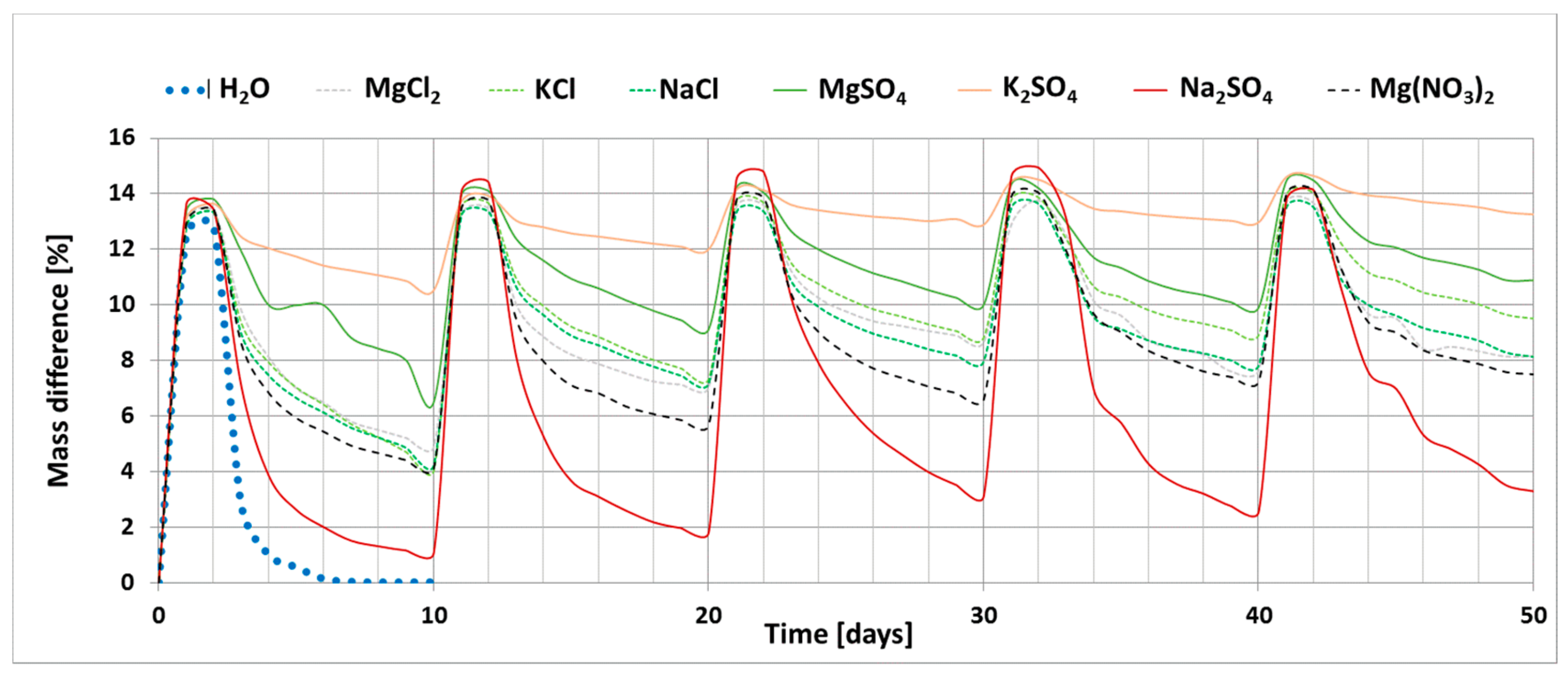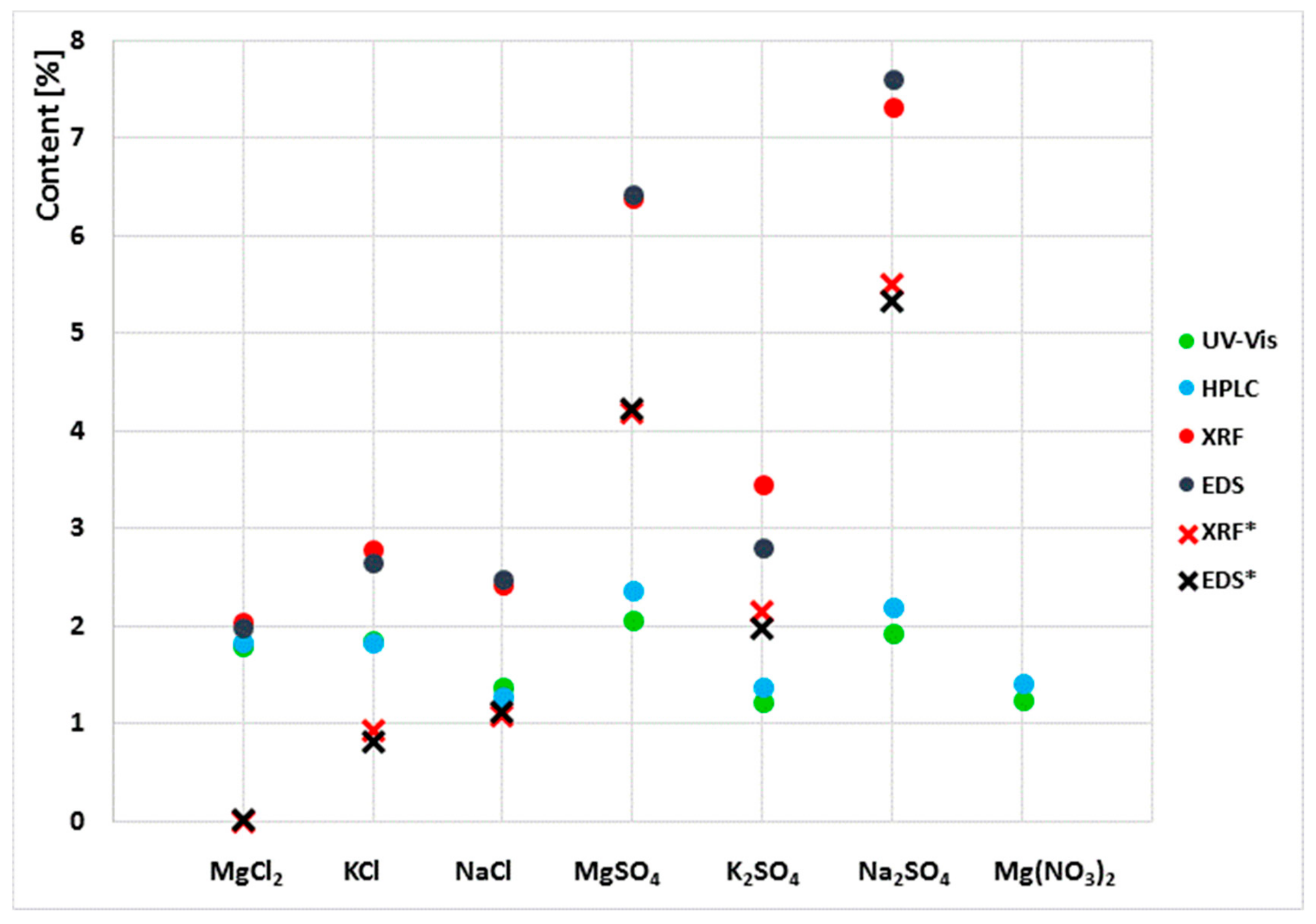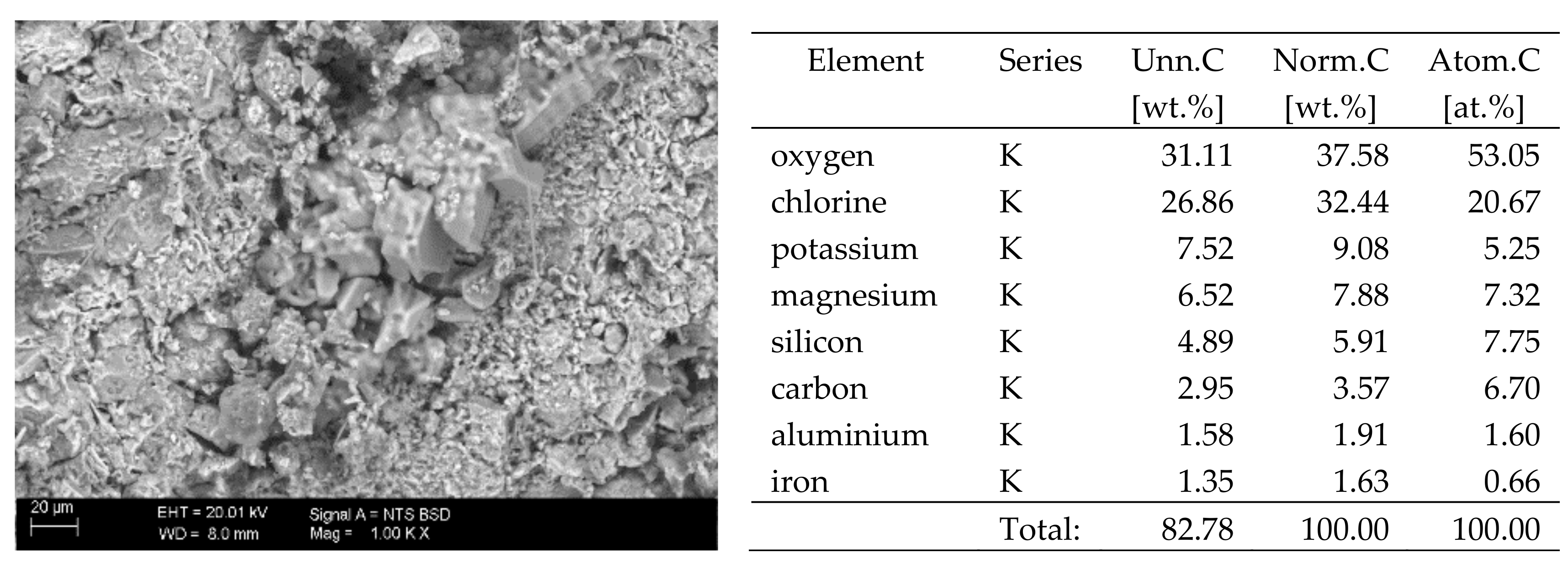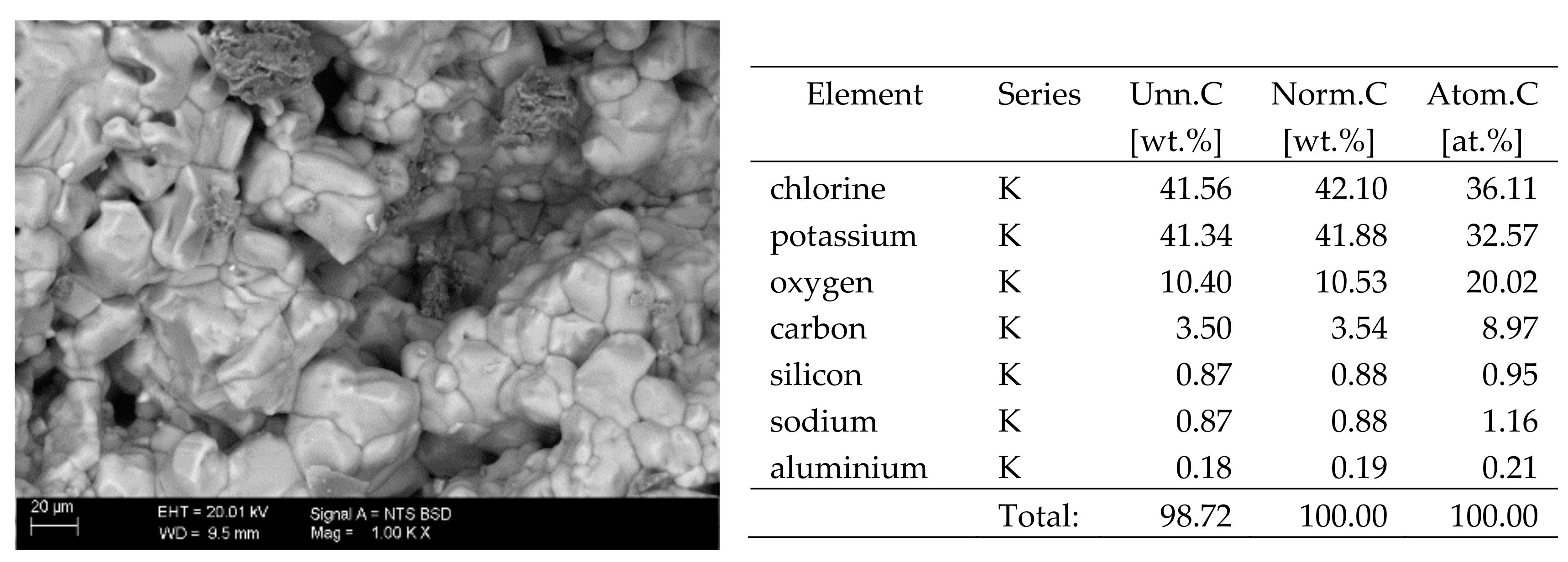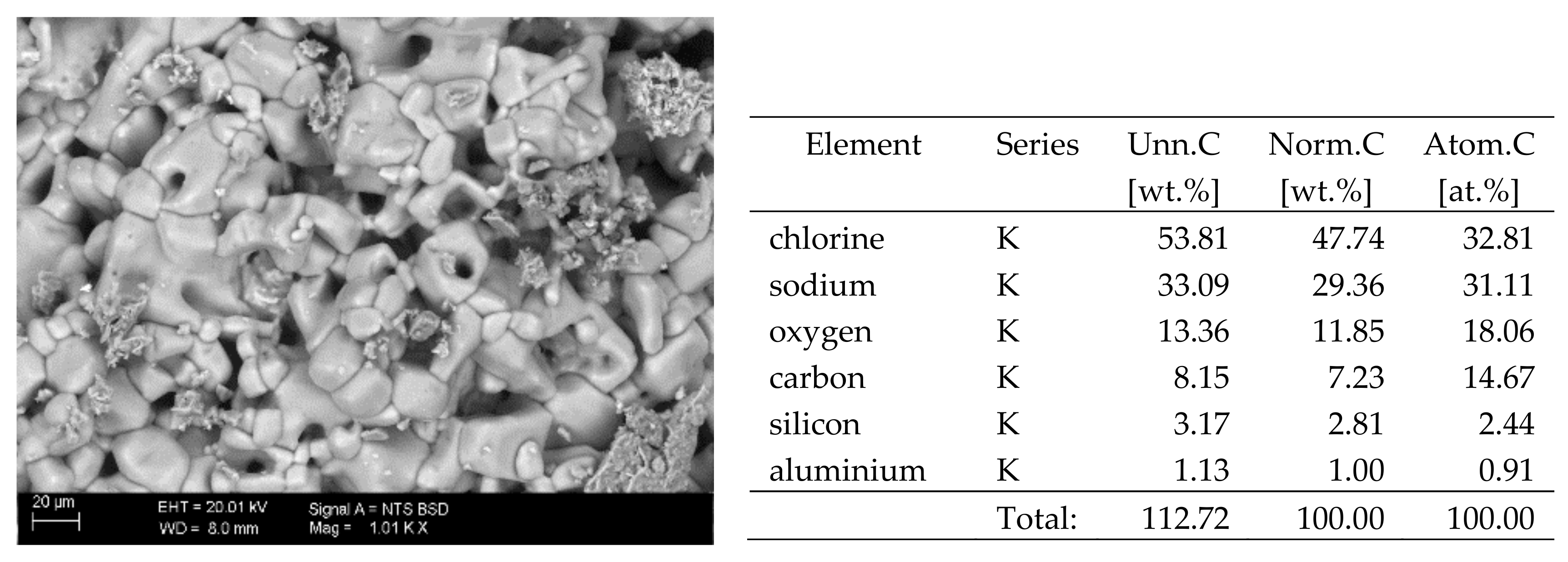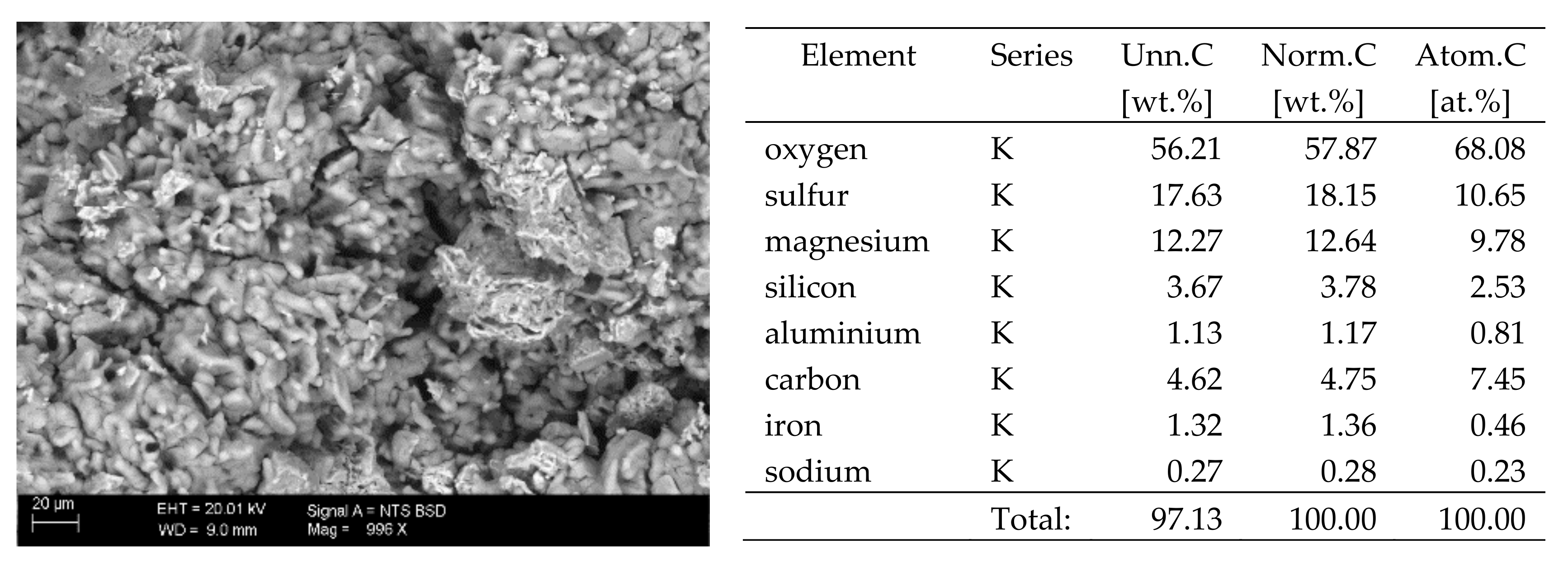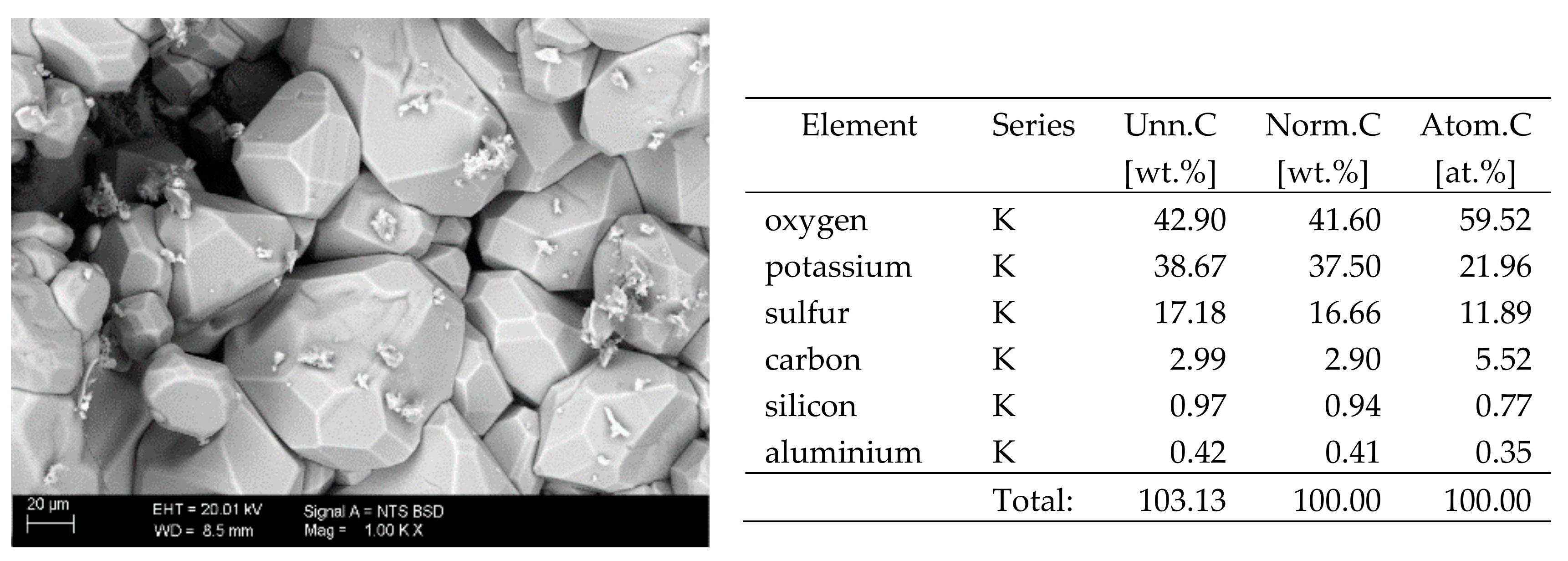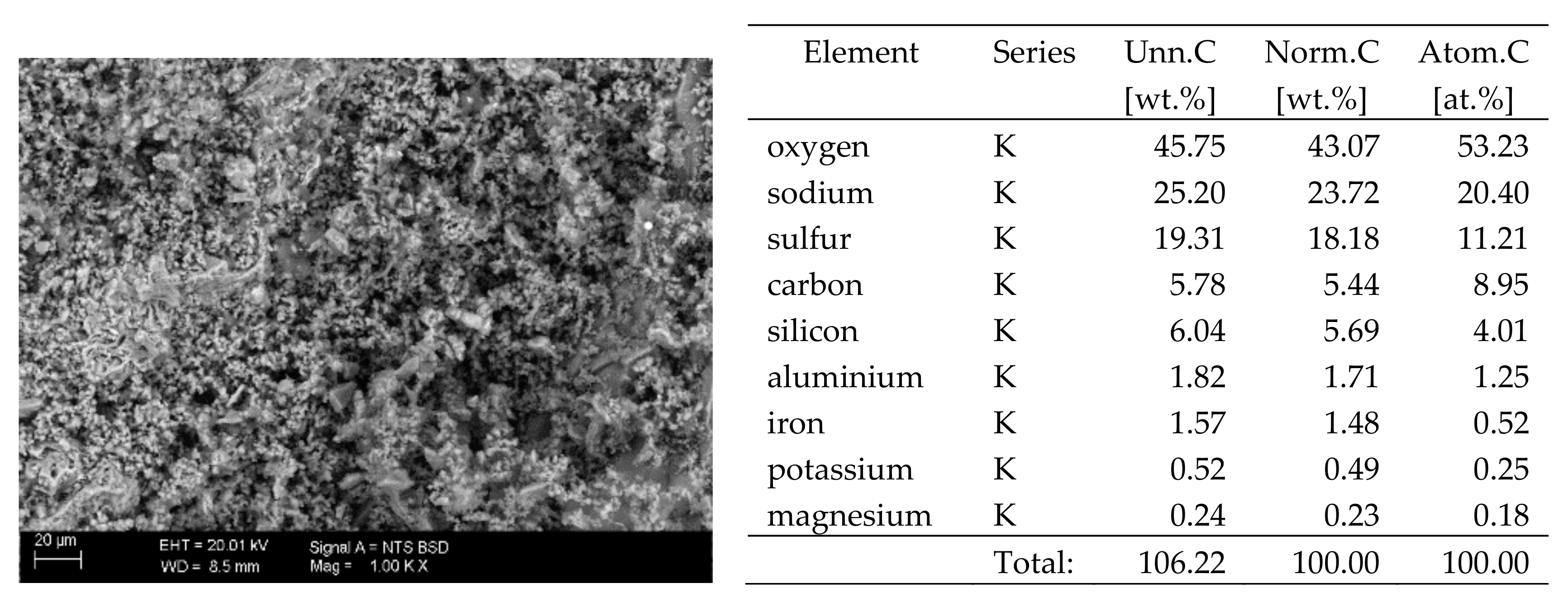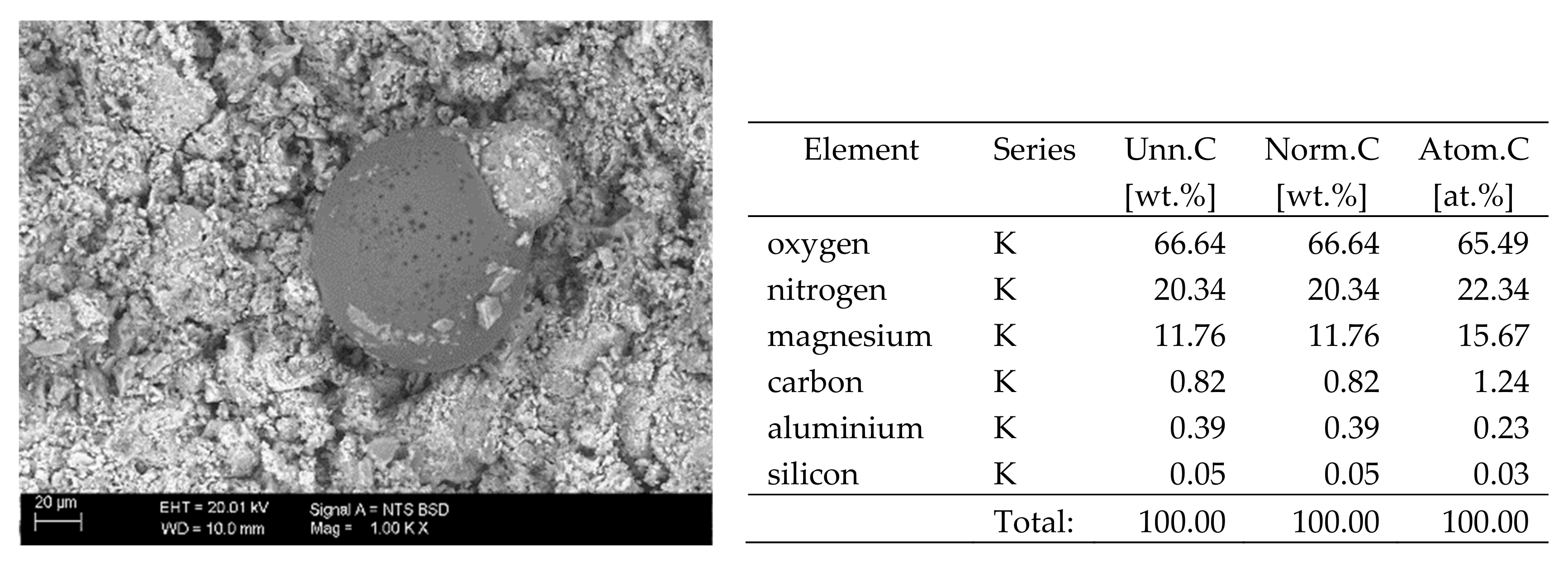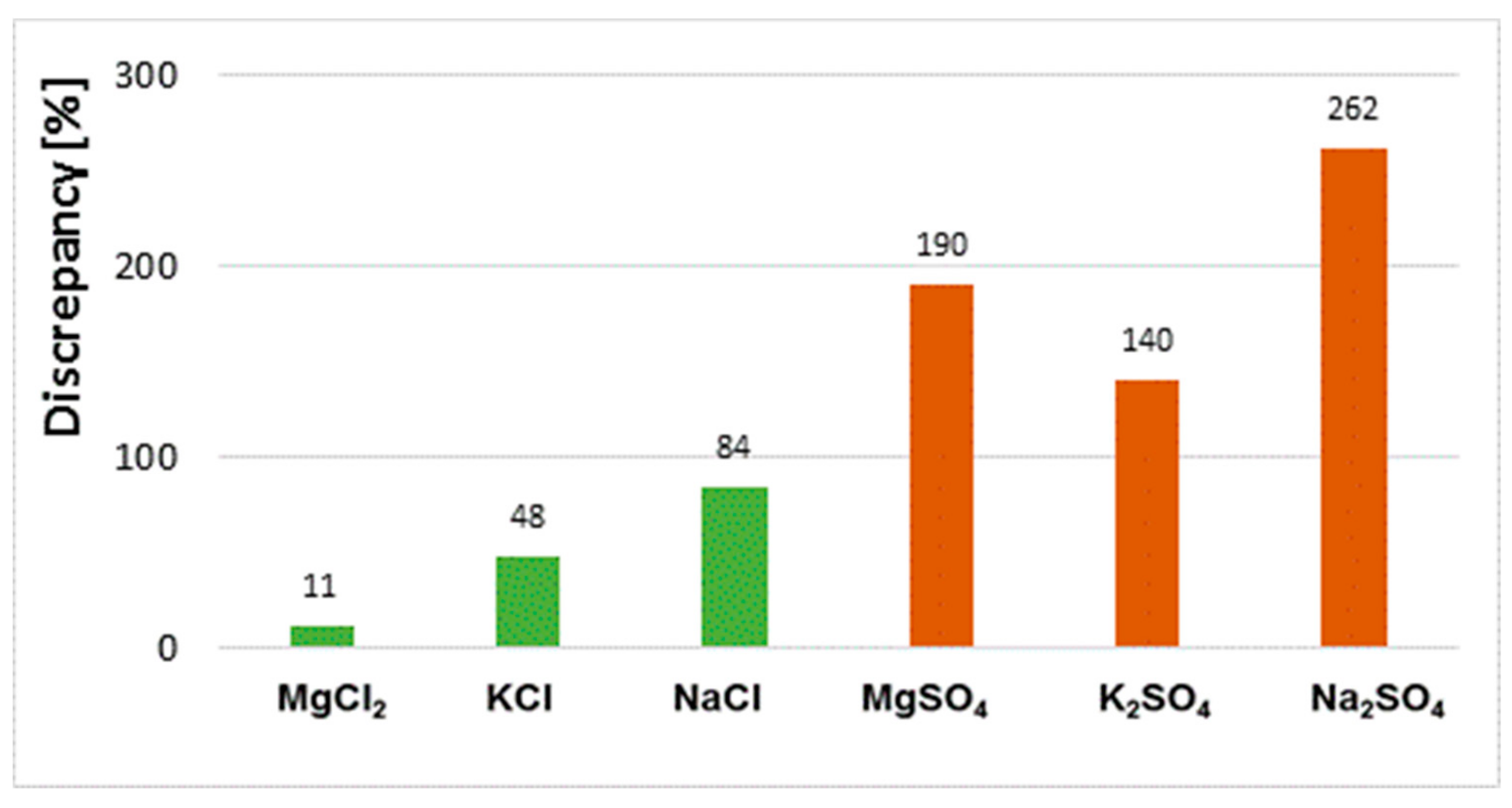1. Introduction
Determination of the level of salinity of buildings is an important element in the assessment of the technical condition of engineering structures. It allows the identification and measurement of the progress of the corrosion processes in the material [
1,
2,
3]. Determination of the content of harmful substances is a necessary stage preceding renovation and conservation works in historic buildings [
1,
4]. There is no clear indication of the method that best reflects the actual salinity of the building materials in use. The commonly applied test methods can be divided into two groups depending on the way in which the sample is prepared. The first of them comprises tests for the content of substances and salts that are soluble in water. The second group are methods that allow determining the content of all (soluble and insoluble) components. The first group comprises methods based on the examination of aqueous extracts. Therefore, for tests of this type the sample has to be ground, mixed with distilled water and left for the soluble components to be leached out. The result obtained by these methods specifies the content of salts and water-soluble substances passed into the solution [
4,
5]. In this case, the result is usually expressed as the ion concentration per unit volume of the solution. This group includes titration, colorimetry, conductometry, spectrophotometry and ion chromatography. The other group of methods includes tests using samples in the solid state. Preparation of the sample typically consists of powdering it. In this group of methods, all types of salts and substances, both soluble and insoluble in water, are recorded. The result is usually a quantitative elemental composition expressed as percentage by weight. The most popular methods in this group are X-ray fluorescence (XRF) and elemental composition analysis by scanning electron microscopy (SEM) with energy-dispersive X-ray spectrometry (EDS), together with an image analysis.
The choice of the test method implies the nature of the result and is closely related to its value. When choosing the test method, it is also necessary to take into account the precision, accuracy if the determinations and the measurement range, the sample size (including the possibility of preparing a representative sample), and the time and cost of analysis.
According WTA guidelines [
1,
6,
7], the recommended method for determining the salt content in walls is by testing aqueous extracts in which SO
42−, Cl
− and NO
3− ion contents are determined. This approach simplifies the issue of the aggressiveness of salt to the ceramic material. Based solely on the results of tests for the content of salt anions in extracts, we are not able to reliably assess the threat to the durability of the material as identification of the type of salt is essentially important [
8,
9]. Moreover, salt solubility is not a measure of aggressiveness of a given solution although it is true that salts with the highest solubility are more dangerous [
10]. The main and direct cause of salt aggressiveness towards the mineral material is not the salt solution itself but first of all crystallisation of salt from this solution [
8,
11,
12,
13,
14,
15].
A wider approach to the assessment of salinity of mineral materials is proposed in “A guide to salt damp in historic and older buildings” [
2], according to which the determination of salt content in materials should be based on a full chemical analysis of cations and anions using, e.g., ion chromatography for the cations and coupled plasma atomic emission spectrometry for the anions. Additionally, full identification of the type and amount of salt facilitates the selection of methods for desalination of walls, which in consequence allows for an effective process of their drying and carrying out conservation work [
9,
11,
16,
17,
18,
19]. Depending on the type and content of salt, the process of degradation of functional properties takes place with different intensity [
8].
The purpose of this paper is to assess the usefulness of testing and analytical methods in examining the salinity of mineral building materials and to try to indicate one of them as the most reliable. Studies were carried out on bricks exposed to chloride, sulphate and nitrate salts in laboratory conditions. The salinity of the bricks was determined by spectrophotometry, high-performance liquid chromatography, X-ray fluorescence and X-ray energy dispersion analysis in a scanning microscope together with microstructure observation. The test techniques were selected in such manner as to obtain a wide range of results with regard to both the content of soluble and insoluble substances and phase identification.
5. Results of Chemical Analysis Tests
The spectrophotometric examination (UV) and liquid ion exchange chromatography (HPLC) were performed on aqueous extracts. For this purpose, after five soaking and drying cycles the samples were ground. Then, distilled water was added at a mass ratio of 1:10 and left for 48 h (stirring every 12 h). After that time, the mixtures were filtered and aqueous extracts were obtained for testing. The spectrophotometric examination determined the content of sulphate ions SO42−, chloride ions Cl− and nitrate ions NO3−. In the ion chromatography examination, a wide spectrum of ions was determined; however, the paper only presents the results for the content of those ions that are the basis for determining the level of salinity of mineral building materials. In both methods the results obtained were expressed in [mg/dm3]; these were then converted relative to the sample mass and expressed as [%] of the mass.
The X-ray fluorescence (XRF) examination and the energy-dispersive X-ray spectrometry (EDS) were performed on powdered samples (the samples were ground in a ball mill) prepared in the form of tablets (powder pressed in a hydraulic press). In both methods, the result is the elemental composition of the materials tested, expressed as [%] of the sample weight. The sulphur content has been converted to SO42− ion. The paper only presents the results pertaining to the harmful substances, i.e. chlorides and sulphates.
The test results presented in the paper (
Table 1 and
Figure 3) are the averaged results of three replicate measurements.
Due to the clear variability of the results obtained in the examination of the extracts and the powder samples, the content of sulphates and chlorides in the sediments left by the aqueous extracts was tested. For this purpose, the sediments were dried to a constant mass at 25 °C. Then, the samples were analysed by XRF and EDS. The results obtained together with those in
Table 1 are shown in
Figure 2.
The results obtained showed that the sum of sulphates and chlorides determined in aqueous extracts and in sediments left by the extracts is the total content of these ions equal to the S and Cl content that was determined in powder samples by XRF and EDS.
7. Discussion of Results
As stated in the introduction, the test methods applied in the paper can be divided into two main groups. One of them comprises methods for testing aqueous extracts, and the other one comprises methods for solid samples (powdered samples). The results obtained clearly indicate differences in sulphate and chloride contents depending on the test method applied. In all cases, the results obtained by X-ray fluorescence (XRF) and energy-dispersive X-ray spectroscopy (EDS) for solid-phase samples are higher than those obtained by ion chromatography (HPLC) and spectrophotometry (UV) for water extracts. For chloride salts, the differences are much smaller, while for sulphate salts, the differences are significantly higher. Note that the results of tests of salt content in liquids made by the two methods are very similar, and likewise the results of tests of solid samples are also very similar. For the NaCl and KCl salts, the results for chloride content determined by the UV and HPLC are almost identical, and so are the results of the chloride content obtained by EDS and XRF. For example, the chloride ion contents in the sample exposed to NaCl salt determined in the aqueous extract are 1.29% and 1.38% of the mass while for the powdered sample they are 2.43% and 2.49% of the mass. The results of tests on samples exposed to sulphate salts are also similar; the results of UV and HPPLC tests for aqueous extracts are very similar like the results of solid-phase tests with EDS and XRF, which are similar too. Nevertheless, the differences between the results depending on the form of the sample are very large, e.g., for Na2SO4, the SO42− ion content in the sample determined in the aqueous extract is ~2% while in the powdered sample it is ~7%. This gives a 300% difference in the results obtained depending on the determination method used. The highest consistency of results, regardless of the test method (EDS, XRF, UV or HPLC), was obtained for samples exposed to the MgCl2 salt. For this sample, the discrepancy between the results does not exceed 5%.
When the NO3− ion content is determined, the results obtained by testing aqueous extracts are identical. Due to the limitations of the XRF and EDS methods with regard to the detection of light elements, the content of nitrates was not determined in the solid phase.
Discrepancies between results obtained by different methods (extract tests and powder tests) for the same sample depend on the type of salt. The variation of results for samples saturated with chloride salts is significantly smaller than for sulphate salts (
Figure 11).
One reason for the lack of homogeneity of the results concerning the chloride and sulphate ion content determined in aqueous extracts and powder samples is the different solubility of each salt in water. Sodium, potassium and magnesium chloride salts have higher solubility in water than sulphate salts of the same metals. The solubility of magnesium, sodium and potassium chloride is 55 g, 36 g and 34 g/100 g H
2O at 20 °C, respectively, whereas that of magnesium, sodium and potassium sulphate is 35 g, 20 g and 11 g/100 g H
2O, respectively. On the other hand, the solubility of magnesium nitrate is the highest of the salts tested, at 70 g/100 g H
2O. Of the chloride and sulphate salts tested, MgCl
2 solubility is the highest. In the case of this salt, the results of the chloride content are very similar regardless of the test method used, and the difference between them is only 11% (
Figure 11). The high solubility of magnesium chloride makes it easy to leach chloride salts from the ceramic matrix into the solution. This promotes the transition of all chlorides from the sample to the aqueous extract. In effect, the results for the chloride contents determined in the extract and in the solid phase (in the powder sample) are the same. However, in the case of low solubility, e.g., for sodium and potassium sulphate, the differences in results between samples (extract, solid sample) are very large. This means that some of the sulphates are not washed out and remain in the solid phase. They are not detected in the water extracts. Moreover, as the authors of the paper have shown [
22], it is difficult to rinse the total amount of salt from the brick and is determined by such factors as fragmentation of the sample and the soaking time.
When analysing the results obtained for solubility of chloride and sulphate salts, note that the greater the solubility, the smaller the difference in results, and vice versa. However, this is not an unequivocal correlation, as is clearly seen in the case of the sample exposed to magnesium sulphate, the solubility of which is at level with that of chloride salts and yet the results vary depending on the test method. One reason for this is the permanent incorporation of some of the magnesium sulphate salts into the texture of the brick. In the studies presented in [
11,
22,
23], it has been shown that sulphate ions introduced into ceramic brick in the form of a MgSO
4 solution can react with calcium ions present in the matrix to produce sparingly soluble calcium sulphate (gypsum) and magnesium hydroxide. This is also possible with sodium and potassium sulphate [
11,
24]. The gypsum formed is a compound with a very low solubility of 0.26 g/100 g H
2O. Therefore, it is extremely difficult to get into solution. Such a mechanism of incorporation of salt into the texture together with the formation of compounds of very low solubility is confirmed by the studies presented in this paper. Studies on chloride and sulphate content carried out on dried sediments (left after aqueous extracts) show that some of the salts, especially the sulphate salts, do not get into solution and remain in the solid phase. Tests of dried sediments (left after extracts) by XRF and EDS showed the presence of sulphur and chlorine in the amount which, when added to the sulphate and chloride content determined by UV and HPLC, gives the total content determined by XRF and EDS in powder samples (
Figure 3). Taking into account the results obtained and their analysis, it can be concluded that each of the analytical methods used is correct. However, depending on the method of measurement (and in particular on the preparation tested), clearly different results can be obtained (for the same material) which should be interpreted differently.
In the analysis of salinity of building materials it is also important to determine the type of salt itself and not only the chloride and sulphate content. When analysing the curves obtained in the drying process (
Figure 2), it was observed that depending on the metal cation (Na, K or Mg) in the chloride or sulphate salt, the drying process is different. For example, sodium sulphate causes a slight weight gain, whereas potassium sulphate causes a fourfold greater gain. Analysing the SEM image of the microstructure of the salt crystals formed, it can be concluded that one of the causes of the differentiation in the drying process may be the size and shape of the crystals formed. The microstructure image analysis shows that K
2SO
4 crystals are the largest among the salts studied and the Na
2SO
4 crystals are the smallest. Furthermore, an increase in the weight of bricks exposed to salt action may not only be the result of salt crystallisation but may also be the result of water retention in the material texture by hygroscopic salt. Prolonged moisture of walls has an adverse effect on the functional properties of buildings, hinders conservation works and also affects the mechanical parameters [
25]. Moreover, depending on the cation, sulphate salts are characterised by different crystallisation pressure and different preferential crystallisation site [
12,
13,
26,
27]. Therefore, their impact on the durability of bricks will vary. The destructive action of salt is intensified by repeated recrystallisation of a given salt in the material texture as is the case with sodium sulphate [
28] and magnesium sulphate [
29]. Depending on the temperature at which the crystallisation process takes place, these salts have different degrees of hydration. The higher the degree of hydration, the greater the volume and higher crystallisation pressures [
5,
12,
30]. The same is true for chloride salts, especially magnesium chloride. As demonstrated in [
30], even small amounts of salt in the material may significantly affect the transport and hygroscopic properties of the material.
8. Conclusions
The investigation has shown that the content of a given salt determined in aqueous extracts by UV and HPLC is very similar. Similarly, when testing the salt content in powder samples by EDS and XRF, the results obtained are also very similar. However, the results in these two groups for a given salt may differ significantly, especially for sulphates. The discrepancies shown in the test results clearly show that the result may vary depending on the method of determination. For chloride salts, the discrepancies are significantly smaller than for sulphate salts. This clearly shows that the adopted test method is of great importance, and the interpretation of test results should always be related to the test method applied. When applying the UV and HPLC methods, note that the result does not necessarily reflect the total salt content. Where salts, especially sulphate salts, are found, it is appropriate and necessary to carry out additional tests, preferably under an electron microscope, together with an analysis of the elemental composition. This makes it possible to assess the total salt content together with the simultaneous identification of the type of salt which has been shown to be very important. This is because the aggressiveness of the salt can not only be associated with its dissolving capacity, but also with the crystallisation pressure, crystal size and the effect on the hygroscopic properties of the material. For this reason, it seems right and justified to recommend conducting salinity tests of walls in a comprehensive manner, enabling full identification of salt types and their content. It seems that the combination of spectrophotometric and scanning methods is the most optimal choice. The spectrophotometric method is a simple and relatively cheap method that does not require very expensive devices. The obtain results give information about the content of the most dangerous substances relative to the building materials, i.e., water soluble. A very important supplement to these tests is the observation in the scanning microscope that allows the identification of the type of phase whose solubility is very different. However, it is a method that requires expensive and specialised equipment as well as the knowledge of the person performing and interpreting the results.

